Perhaps you have already been hooked by this grass while crossing an abandoned field; it is in fact part of what is called anthropophilic vegetation which, in a jumble of mixed plants, quickly colonizes any territory abandoned by man. This “policeman” lives in the warm regions of Asia and Africa and was introduced to America. Linnaeus named it Achyranthes aspera.
It is a perennial plant that can reach 2 meters high; its leaves are opposite, entire, almost stuck to the stem. The inflorescences are very long spikes, crossed by the future flowers which open at their end, greenish with red sepals. Before opening these flowers are enclosed in hard and prickly bracts which, taken against the grain, catch everything that passes: clothes, animal fur, human skin.
The scientific name is, in this respect, quite expressive, it is formed from achyron, “straw” and anthos, “flower” to which Linnaeus added aspera, “rough”. The English name is the translation, “Straw Flower”, but we also find Devil’s Horsewhip, which indicates the aggressive aspect of these ears, like the French name “gendarme”. For the Cambodians this grass is rough like an “ox tongue”. The Lao are much more realistic and visual since they see in this grass a “snake penis”, khoy ngou and children, in the countryside still play the “snake game”. They use this catchy faculty of the inflorescence to advance, head to tail, two segments of the ear along the arms, it’s the one who will go the fastest!
This thicket grass is therefore very interesting, especially since it has many medicinal applications. Its leaves are used in decoction to “cleanse” the body; they are crushed and applied to wounds, painful joints, abscesses; the young woman who has just given birth is treated with them for internal or external use. In India there are more than thirty uses of the roots of this Achyranthes from dental care to numerous stomach and abdominal aches, including hysteria, rabies and cholera. Finally, let us point out that in Cambodia smav ondat ko is used in certain rituals, in particular those linked to the return of paddy to the granaries.
Peut-être avez-vous déjà été accroché à cette herbe en traversant un terrain à l’abandon; elle fait en effet partie de ce que l’on nomme la végétation anthropophile qui, dans un fouillis de plantes mêlées, colonise rapidement tout territoire abandonné par l’homme. Ce « gendarme » habite les régions chaudes d’Asie et d’Afrique et a été introduit en Amérique. Linné l’a nommé Achyranthes aspera.
C’est une plante vivace qui peut atteindre 2 mètres de haut; ses feuilles sont opposées, entières, presque collées à la tige. Les inflorescences sont de très longs épis, parcourus des futures fleurs qui s’ouvrent à leur extrémité, verdâtres avec des sépales rouges. Avant de s’ouvrir ces fleurs sont enfermées dans des bractées dures et piquantes qui, prises à rebrousse-poil, accrochent tout ce qui passe: vêtements, pelage des animaux, peau humaine.
Le nom scientifique est, à cet égard, assez expressif, il est formé de achyron, « paille » et anthos, « fleur » auquel Linné a rajouté aspera, « rugueux ». Le nom anglais en est la traduction, « fleur de paille », mais on trouve également devil’s horsewhip, « fouet du diable » qui indique l’aspect agressif de ces épis, comme le nom français « gendarme ». Pour les Cambodgiens cette herbe est rugueuse comme une « langue de bœuf ». Les Lao sont beaucoup plus réalistes et visuels puisqu’ils voient dans cette herbe un « pénis de serpent », khoy ngou et les enfants, dans les campagnes jouent encore au « jeu du serpent ». Ils utilisent cette faculté accrocheuse de l’inflorescence pour faire progresser, tête bêche, deux segments de l’épi le long des bras, c’est à celui qui ira le plus vite !
Cette herbe des fourrés se révèle donc très intéressante, d’autant plus qu’elle a de nombreuses applications médicinales. Ses feuilles sont employées en décoction pour « nettoyer » l’organisme; elles sont écrasées et appliquées sur les plaies, les articulations douloureuses, les abcès; la jeune accouchée est soignée avec elles en usage interne ou externe. En Inde on compte plus de trente usages des racines de cet Achyranthes depuis les soins dentaires jusqu’aux nombreux maux de ventre et d’estomac en passant par l’hystérie, la rage et le choléra. Signalons enfin qu’au Cambodge smav ondat ko est employé dans certain rituel, en particulier dans ceux liés à la rentrée du paddy dans les greniers.
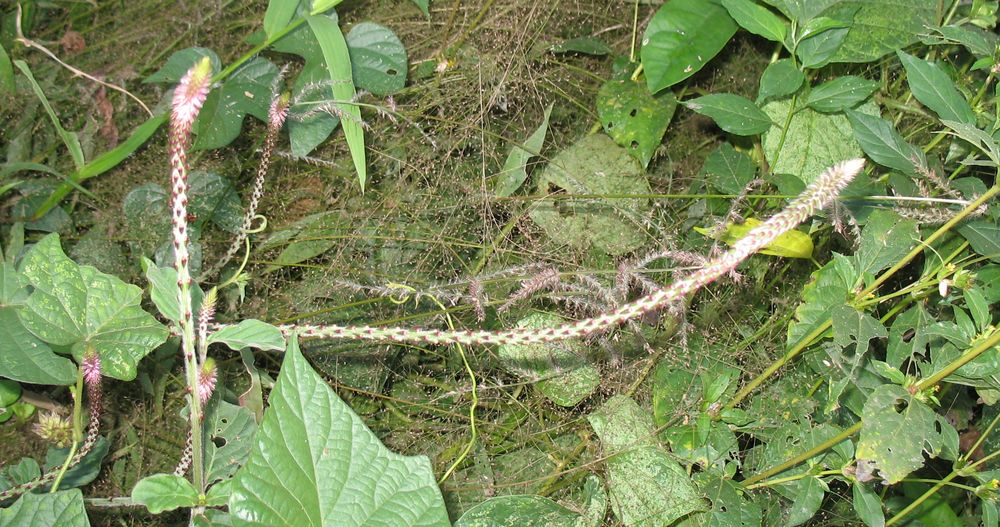
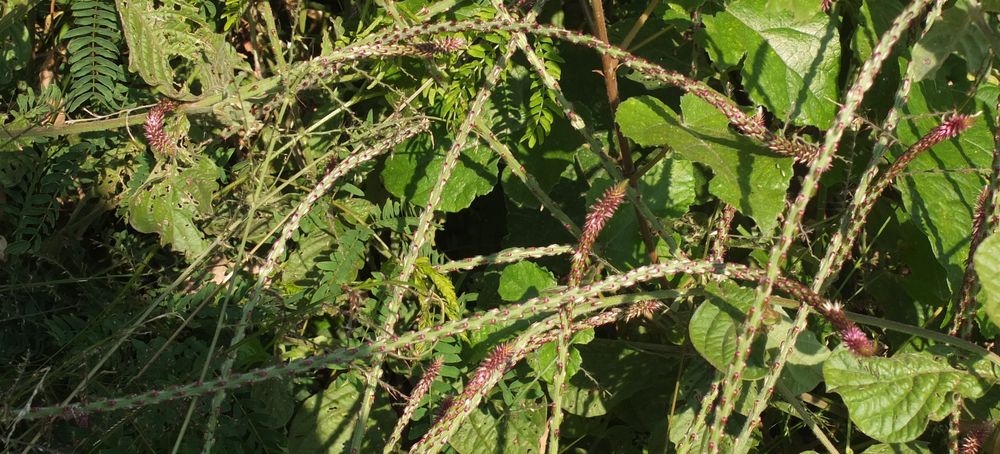
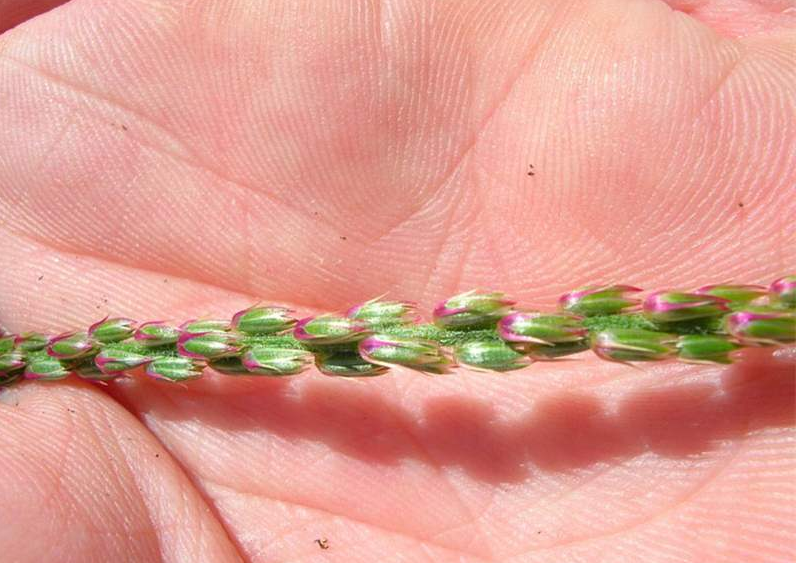
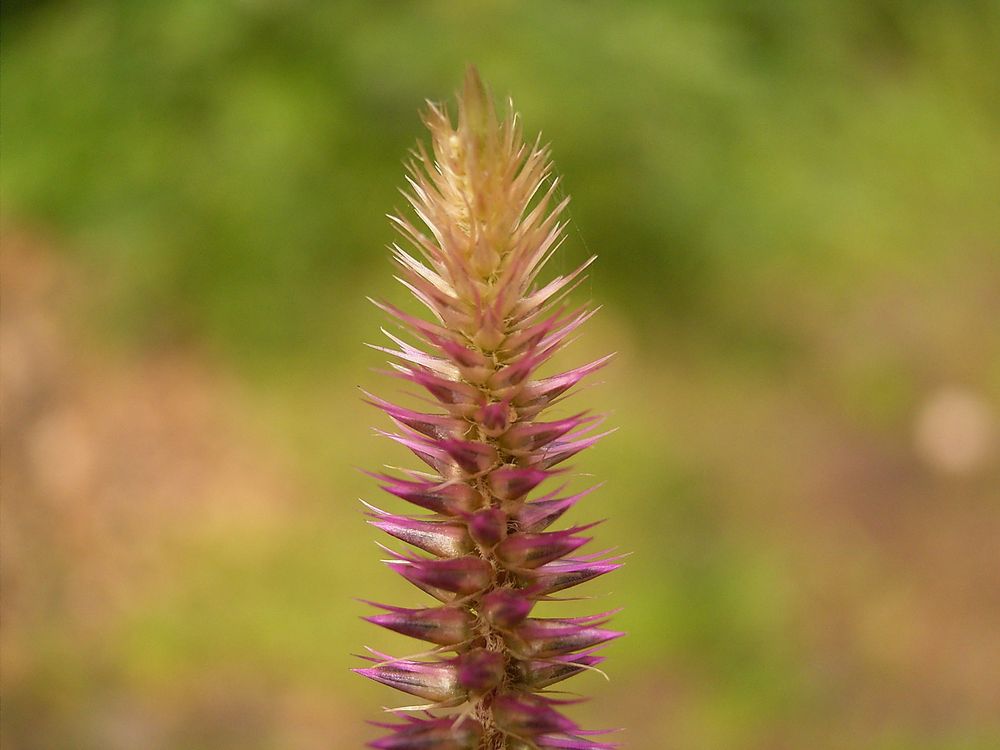
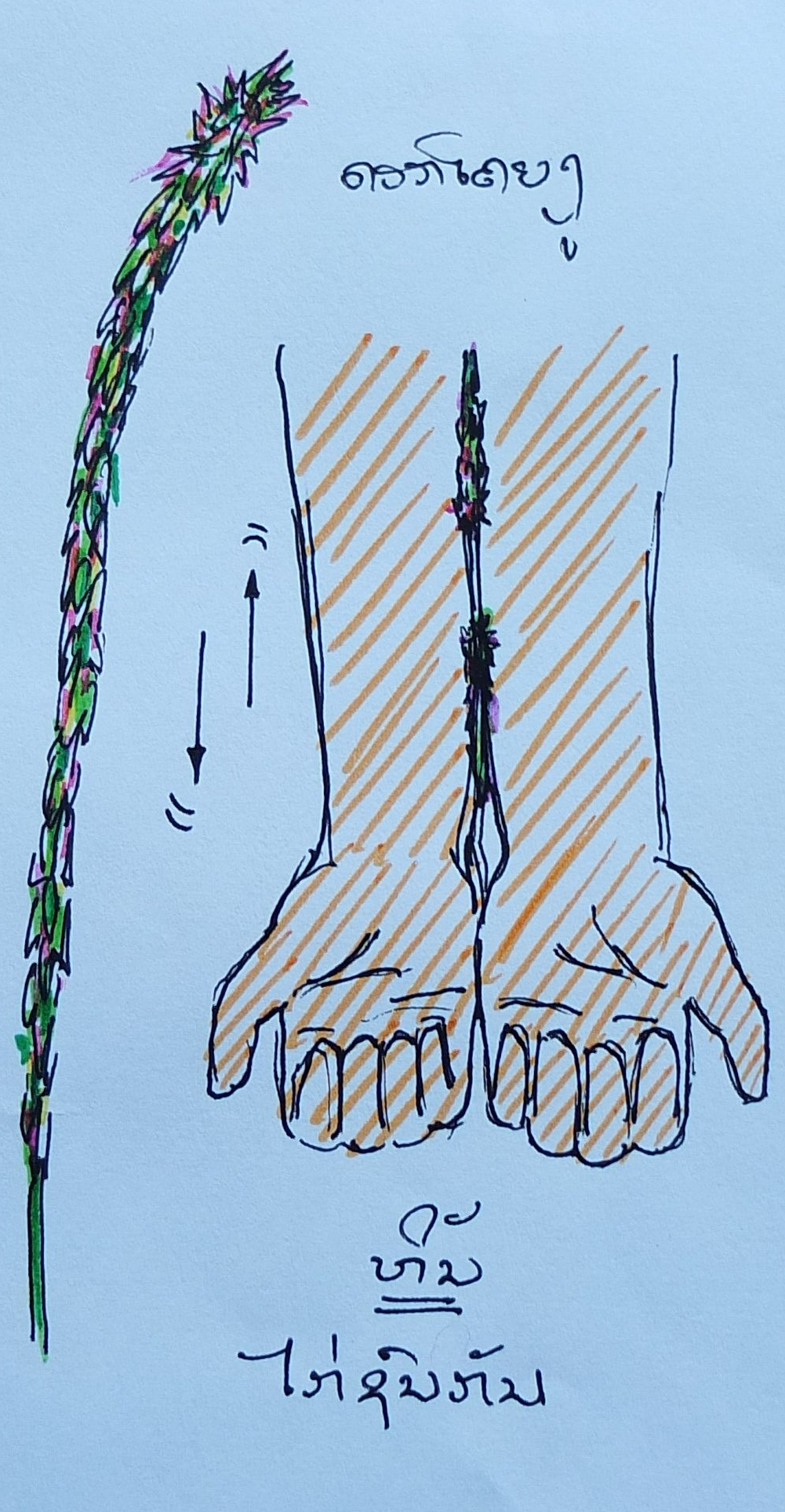
Perhaps you have already been hooked by this grass while crossing an abandoned field; it is in fact part of what is called anthropophilic vegetation which, in a jumble of mixed plants, quickly colonizes any territory abandoned by man. This “policeman” lives in the warm regions of Asia and Africa and was introduced to America. Linnaeus named it Achyranthes aspera.
It is a perennial plant that can reach 2 meters high; its leaves are opposite, entire, almost stuck to the stem. The inflorescences are very long spikes, crossed by the future flowers which open at their end, greenish with red sepals. Before opening these flowers are enclosed in hard and prickly bracts which, taken against the grain, catch everything that passes: clothes, animal fur, human skin.
The scientific name is, in this respect, quite expressive, it is formed from achyron, “straw” and anthos, “flower” to which Linnaeus added aspera, “rough”. The English name is the translation, “Straw Flower”, but we also find Devil’s Horsewhip, which indicates the aggressive aspect of these ears, like the French name “gendarme”. For the Cambodians this grass is rough like an “ox tongue”. The Lao are much more realistic and visual since they see in this grass a “snake penis”, khoy ngou and children, in the countryside still play the “snake game”. They use this catchy faculty of the inflorescence to advance, head to tail, two segments of the ear along the arms, it’s the one who will go the fastest!
This thicket grass is therefore very interesting, especially since it has many medicinal applications. Its leaves are used in decoction to “cleanse” the body; they are crushed and applied to wounds, painful joints, abscesses; the young woman who has just given birth is treated with them for internal or external use. In India there are more than thirty uses of the roots of this Achyranthes from dental care to numerous stomach and abdominal aches, including hysteria, rabies and cholera. Finally, let us point out that in Cambodia smav ondat ko is used in certain rituals, in particular those linked to the return of paddy to the granaries.
Peut-être avez-vous déjà été accroché à cette herbe en traversant un terrain à l’abandon; elle fait en effet partie de ce que l’on nomme la végétation anthropophile qui, dans un fouillis de plantes mêlées, colonise rapidement tout territoire abandonné par l’homme. Ce « gendarme » habite les régions chaudes d’Asie et d’Afrique et a été introduit en Amérique. Linné l’a nommé Achyranthes aspera.
C’est une plante vivace qui peut atteindre 2 mètres de haut; ses feuilles sont opposées, entières, presque collées à la tige. Les inflorescences sont de très longs épis, parcourus des futures fleurs qui s’ouvrent à leur extrémité, verdâtres avec des sépales rouges. Avant de s’ouvrir ces fleurs sont enfermées dans des bractées dures et piquantes qui, prises à rebrousse-poil, accrochent tout ce qui passe: vêtements, pelage des animaux, peau humaine.
Le nom scientifique est, à cet égard, assez expressif, il est formé de achyron, « paille » et anthos, « fleur » auquel Linné a rajouté aspera, « rugueux ». Le nom anglais en est la traduction, « fleur de paille », mais on trouve également devil’s horsewhip, « fouet du diable » qui indique l’aspect agressif de ces épis, comme le nom français « gendarme ». Pour les Cambodgiens cette herbe est rugueuse comme une « langue de bœuf ». Les Lao sont beaucoup plus réalistes et visuels puisqu’ils voient dans cette herbe un « pénis de serpent », khoy ngou et les enfants, dans les campagnes jouent encore au « jeu du serpent ». Ils utilisent cette faculté accrocheuse de l’inflorescence pour faire progresser, tête bêche, deux segments de l’épi le long des bras, c’est à celui qui ira le plus vite !
Cette herbe des fourrés se révèle donc très intéressante, d’autant plus qu’elle a de nombreuses applications médicinales. Ses feuilles sont employées en décoction pour « nettoyer » l’organisme; elles sont écrasées et appliquées sur les plaies, les articulations douloureuses, les abcès; la jeune accouchée est soignée avec elles en usage interne ou externe. En Inde on compte plus de trente usages des racines de cet Achyranthes depuis les soins dentaires jusqu’aux nombreux maux de ventre et d’estomac en passant par l’hystérie, la rage et le choléra. Signalons enfin qu’au Cambodge smav ondat ko est employé dans certain rituel, en particulier dans ceux liés à la rentrée du paddy dans les greniers.










Perhaps you have already been hooked by this grass while crossing an abandoned field; it is in fact part of what is called anthropophilic vegetation which, in a jumble of mixed plants, quickly colonizes any territory abandoned by man. This “policeman” lives in the warm regions of Asia and Africa and was introduced to America. Linnaeus named it Achyranthes aspera.
It is a perennial plant that can reach 2 meters high; its leaves are opposite, entire, almost stuck to the stem. The inflorescences are very long spikes, crossed by the future flowers which open at their end, greenish with red sepals. Before opening these flowers are enclosed in hard and prickly bracts which, taken against the grain, catch everything that passes: clothes, animal fur, human skin.
The scientific name is, in this respect, quite expressive, it is formed from achyron, “straw” and anthos, “flower” to which Linnaeus added aspera, “rough”. The English name is the translation, “Straw Flower”, but we also find Devil’s Horsewhip, which indicates the aggressive aspect of these ears, like the French name “gendarme”. For the Cambodians this grass is rough like an “ox tongue”. The Lao are much more realistic and visual since they see in this grass a “snake penis”, khoy ngou and children, in the countryside still play the “snake game”. They use this catchy faculty of the inflorescence to advance, head to tail, two segments of the ear along the arms, it’s the one who will go the fastest!
This thicket grass is therefore very interesting, especially since it has many medicinal applications. Its leaves are used in decoction to “cleanse” the body; they are crushed and applied to wounds, painful joints, abscesses; the young woman who has just given birth is treated with them for internal or external use. In India there are more than thirty uses of the roots of this Achyranthes from dental care to numerous stomach and abdominal aches, including hysteria, rabies and cholera. Finally, let us point out that in Cambodia smav ondat ko is used in certain rituals, in particular those linked to the return of paddy to the granaries.
Peut-être avez-vous déjà été accroché à cette herbe en traversant un terrain à l’abandon; elle fait en effet partie de ce que l’on nomme la végétation anthropophile qui, dans un fouillis de plantes mêlées, colonise rapidement tout territoire abandonné par l’homme. Ce « gendarme » habite les régions chaudes d’Asie et d’Afrique et a été introduit en Amérique. Linné l’a nommé Achyranthes aspera.
C’est une plante vivace qui peut atteindre 2 mètres de haut; ses feuilles sont opposées, entières, presque collées à la tige. Les inflorescences sont de très longs épis, parcourus des futures fleurs qui s’ouvrent à leur extrémité, verdâtres avec des sépales rouges. Avant de s’ouvrir ces fleurs sont enfermées dans des bractées dures et piquantes qui, prises à rebrousse-poil, accrochent tout ce qui passe: vêtements, pelage des animaux, peau humaine.
Le nom scientifique est, à cet égard, assez expressif, il est formé de achyron, « paille » et anthos, « fleur » auquel Linné a rajouté aspera, « rugueux ». Le nom anglais en est la traduction, « fleur de paille », mais on trouve également devil’s horsewhip, « fouet du diable » qui indique l’aspect agressif de ces épis, comme le nom français « gendarme ». Pour les Cambodgiens cette herbe est rugueuse comme une « langue de bœuf ». Les Lao sont beaucoup plus réalistes et visuels puisqu’ils voient dans cette herbe un « pénis de serpent », khoy ngou et les enfants, dans les campagnes jouent encore au « jeu du serpent ». Ils utilisent cette faculté accrocheuse de l’inflorescence pour faire progresser, tête bêche, deux segments de l’épi le long des bras, c’est à celui qui ira le plus vite !
Cette herbe des fourrés se révèle donc très intéressante, d’autant plus qu’elle a de nombreuses applications médicinales. Ses feuilles sont employées en décoction pour « nettoyer » l’organisme; elles sont écrasées et appliquées sur les plaies, les articulations douloureuses, les abcès; la jeune accouchée est soignée avec elles en usage interne ou externe. En Inde on compte plus de trente usages des racines de cet Achyranthes depuis les soins dentaires jusqu’aux nombreux maux de ventre et d’estomac en passant par l’hystérie, la rage et le choléra. Signalons enfin qu’au Cambodge smav ondat ko est employé dans certain rituel, en particulier dans ceux liés à la rentrée du paddy dans les greniers.


